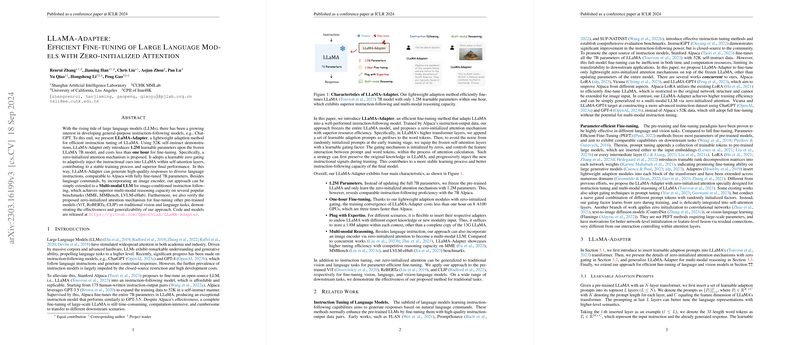LLaMA-Adapter: A Lightweight Approach to Fine-tuning LLaMA for Instruction-following Tasks
Introduction
The advent of instruction-following models like ChatGPT and Alpaca has highlighted the impressive generative capabilities of LLMs when tailored to understand and respond to commands in natural language. However, the process of adapting these models to specific tasks has traditionally been resource-intensive, both in terms of computational power and time. Addressing this challenge, we introduce the LLaMA-Adapter, a method that efficiently adapts the LLaMA model to become an instruction-following powerhouse with minimal additional parameter load and training time.
Efficient Fine-tuning Strategy
At the heart of LLaMA-Adapter is a novel approach that builds upon the existing LLaMA 7B model, appending learnable adaption prompts to the word tokens at higher transformer layers. A distinctive feature of this method is the use of zero-initialized attention mechanisms, equipped with zero gating, to adaptively introduce new instructions without overwhelming the model's pre-trained knowledge base. This strategy not only ensures the preservation of the original LLaMA abilities but also facilitates the seamless integration of new instructional capabilities.
Key highlights include:
- 1.2M Parameters: The approach significantly reduces the parameter count to 1.2M learnable components, in stark contrast to the full 7B parameter update as in previous methods like Alpaca.
- One-hour Fine-tuning: Leveraging a minimal parameter increase and computational optimizations, fine-tuning LLaMA-Adapter completes in an impressively short time frame on 8 A100 GPUs.
- Adaptable Expertise: The method's flexibility lies in its ability to incorporate varied domain-specific knowledge through distinct adapters, negating the need for multiple full-model copies.
- Multi-modal Instruction Capability: Extending beyond text, LLaMA-Adapter adeptly handles image-based instructions, paving the way for multi-modal reasoning and applications.
Generalization Across Tasks
Beyond language understanding and generation, LLaMA-Adapter's utility spans to adapting pre-trained models for vision and language tasks. Our experiments demonstrate the model's adeptness in fine-tuning Vision Transformers (ViTs) and RoBERTa for downstream tasks, showcasing exceptional performance improvements and generalization capabilities across domains.
Evaluation and Results
LLaMA-Adapter has been rigorously evaluated against benchmark datasets like ScienceQA, COCO Caption, SQuAD, and VTAB-1k. These evaluations underscore the model's adeptness at instruction-following, multi-modal reasoning, and its performance on traditional vision and language tasks. Comparisons with existing models like Alpaca and various fine-tuning methods affirm LLaMA-Adapter's superior efficiency, accuracy, and versatility.
Discussion and Future Directions
LLaMA-Adapter represents a significant advancement in the efficient adaptation of LLMs for specialized tasks and multi-modal instructions. With its minimal parameter footprint and quick adaptation time, it offers a promising avenue for deploying sophisticated AI capabilities on constrained hardware or in scenarios where rapid model updates are necessary. Looking ahead, we envision further exploration into extending this framework to accommodate a broader array of modalities, including but not limited to audio, video, and 3D data, potentially setting a new standard for creating versatile, instruction-following AI models.
Conclusion
In conclusion, LLaMA-Adapter stands out as a game-changer in the field of fine-tuning LLMs, particularly for instruction-following tasks. It balances efficiency with performance and opens new horizons for the application of LLMs across varied domains, including those requiring quick model adaptation and multi-modal reasoning capabilities. This work not only demonstrates the feasibility of creating more adaptable and responsive AI systems but also lays the groundwork for future innovations in the field.
